Logitech launch webcam viral promotion
Posted in: UncategorizedLONDON – Consumer technology company Logitech has launched a viral game to drive sales of its webcam products.
LONDON – Consumer technology company Logitech has launched a viral game to drive sales of its webcam products.
To promote Carson Kressley’s new Lifetime series How to Look Good Naked, 160 women will parade their way to New York’s Times Square today via taxi and subway wearing bathrobes while conspicuously carrying their bras in one hand. One…
LONDON — Malcolm Earnshaw, the former director general of ISBA, received a CBE in the New Year’s Honours List.

It seems the bone of contention over Facebook’s Beacon application was but the tip of the iceberg. Now Wired is exploring the company’s “Social Ad” platform and raising more questions about consent and privacy.
Have you used Facebook to give a shout-out to businesses you like? Best make sure your profile picture catches your best side, because you might be an unwitting star in those businesses’ next Facebook ad campaigns.
These ads, bought by participating businesses, insert your name and profile picture directly into their pitches. Based on anecdotal evidence, the ads started to roll out right before the holidays.
According to Facebook, a user has to take a “social action” in order to trigger the appearance of their name and picture in an advertisement.
Egg is hard to get off one’s face. Especially when it dries.
I can just hear the Facebookies explaining the concept to the ad buyers. UGC is all that, blah blah blah…But the problem is none of this matches up to user generated content. It’s all Facebook generated content riding on the backs of mostly unwitting users.
 Philadelphia’s new uwishunu tourism campaign extends, at least to my eye, the funereal themes that have previously appeared in ads for the city’s attractions. In the latest effort, we’re invited to ponder what’s going on inside various locked and gated venues, all of which resemble cemeteries or vampire castles. The ad here features some sort of hook dangling from a wall. It looks like a torture device. (Don’t try to get in. Run away!) See two more ads here. The overposed models are creepy, as though they’re promoting Transylvania. All that said, iduwishinu what is behind those gates. If it’s a human sacrifice and/or karaoke night, book my flight to Philly!
Philadelphia’s new uwishunu tourism campaign extends, at least to my eye, the funereal themes that have previously appeared in ads for the city’s attractions. In the latest effort, we’re invited to ponder what’s going on inside various locked and gated venues, all of which resemble cemeteries or vampire castles. The ad here features some sort of hook dangling from a wall. It looks like a torture device. (Don’t try to get in. Run away!) See two more ads here. The overposed models are creepy, as though they’re promoting Transylvania. All that said, iduwishinu what is behind those gates. If it’s a human sacrifice and/or karaoke night, book my flight to Philly!
—Posted by David Gianatasio
 One of my favourite exhibition spaces for new media art is the Edith Russ Haus in Oldenburg (Germany). It’s hell to get there from Berlin. Hell as in 3 different trains and although they are the usual super comfortable kind you expect from the German railway services, it’s still a total of 7 hours spent in stations and wagons for a return trip. But once you’re back from Oldenburg, there isn’t any doubt left: the quality of the show was worth the transport tedium.
One of my favourite exhibition spaces for new media art is the Edith Russ Haus in Oldenburg (Germany). It’s hell to get there from Berlin. Hell as in 3 different trains and although they are the usual super comfortable kind you expect from the German railway services, it’s still a total of 7 hours spent in stations and wagons for a return trip. But once you’re back from Oldenburg, there isn’t any doubt left: the quality of the show was worth the transport tedium.
The current exhibition, Ecomedia – Ecological Strategies in Today’s Art, presents projects founded on progressive ecological models and conceive utopian horizons in the process. It peruses fundamental considerations concerning ecosystems, sustainability, renewable energy sources, as well as visions of the future. In addition, it examines the role of art and new media over and above science, technology, and ecoactivism. I liked the theme, the way the curators explored it but most of all i found that the works on show were of particularly good quality, individually and as a whole.
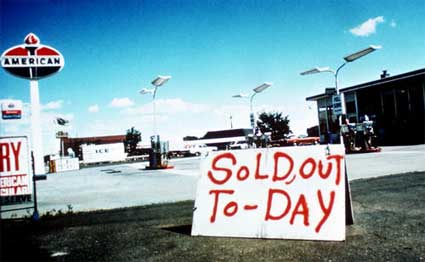
1973 oil crisis
The work that moved me the most is Christina Hemauer’s and Roman Keller’s video and installation work, A Moral Equivalent of War: A Curiosity, a Museum Piece and an Example of a Road not Taken (2006-7). Reading news headlines yesterday, i realized how meaningful the work is. The title of the work, inspired by a television speech to the Nation delivered by Jimmy Carter in 1977, documents the artists’ quest for the solar panels that President Carter had mounted on the roof of the West Wing of the White House in 1979 during a moment of awareness of the dangers of the US’ dependence on foreign oil.

Dedication of the solar panels
In 1977 Carter convinced the Democratic Congress to create the US Department of Energy. Promoting the department’s recommendation to conserve energy, Carter wore sweaters, had solar panels installed on the roof of the White House, had a wood stove in his living quarters, and requested that Christmas decorations remain dark in 1979 and 1980.

Christina Hemauer/Roman Keller: A Moral Equivalent of War, 2007. Image courtesy of Edith Russ Haus
In 1991, «America’s Environmental College», Unity College in Maine, tracked the panels, found them in a warehouse just outside DC, bought them for peanuts and installed them on the roof of their dining room. Hemauer and Keller strapped one of the panels to the roof of their car and drove from Maine to the Jimmy Carter Library and Museum in Atlanta, filming a documentary along the way, interviewing people who had been involved in the solar panel experiment, and reopening a dialogue about present energy policy.
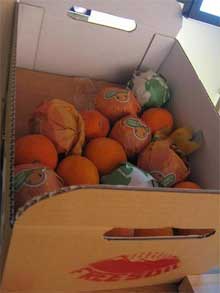 Just like A Moral Equivalent of War, The Acorn Pig Cinema, MILKproject and F.R.U.I.T. are projects which slap you in the face with all their relevance.
Just like A Moral Equivalent of War, The Acorn Pig Cinema, MILKproject and F.R.U.I.T. are projects which slap you in the face with all their relevance.
We keep reading that eating local food might not always be such a good idea. Sometimes the food is sent on huge globetrotting journeys whether the reason for the trip is that english prawns are cheaper when shelled in Asia or that lamb is four times more energy-efficient when imported from the other side of the world than when it is bought from a producer in your backyard. Eating local can have damaging effects on African organic farmers. You can’t make feta in Yorkshire and we should all start thinking about adopting a vegetable.
FRUIT, by Free Soil, invites visitors to take their ecological knowledge into their own hands, by becoming aware of the entire life of a product, from production to utilization, and not just what they see in the stores. Consumers must be aware that every phase of a product’s life influences the environment and ourselves. F.R.U.I.T wrappers, a website, and a traveling installation are part of an initiative to inform people about alternative food systems and local food movements.
Free Soil uses oranges as a vehicle to explore the complex relationships that make up the worlds Food Systems. The oranges –that Free Soil found at the Oldenburg local distributor– in Winter come from South Africa. This means that they have been underway at least one month by boat. This is also why it is practically impossible to have organic oranges at this time of year as most of them would rot if they were not treated chemically.
MILK, a project by Esther Polak, Ieva Auzina and Rixc, follows the milk from the cow to the table of the consumer. All the participants, from Latvian farmers to Dutch cheese makers and market salesmen, were given a GPS device for one of the days that saw them involved in the movements of the dairy product.
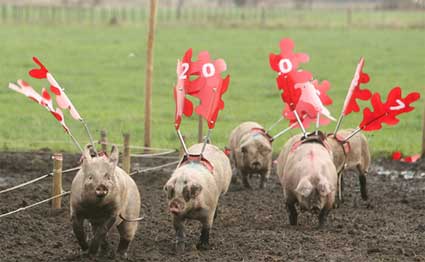
Insa Winkler: Das Eichelschwein Kino Mobil. Image courtesy of Edith Russ Haus
Insa Winkler‘s work intends to make us reflect on the globally implemented industrial farming.
In a mass production factory located Wülknitz, a municipality in Saxony (Germany), pigs destined to become Tyrolean bacon are fattened. Wülknitz is situated in a highly exploited mono-cultivated land and suffers greatly from an exodus of the population.
How is it that the famous Tyrolean bacon can make its name by means of anonymous pigs from Saxony? If these pigs can be made into Tyrolean bacon, then it should also be possible to produce a speciality of equal quality – the “Saxon acorn ham†– in a setting which is worth living in for both man and animal in compliance with the premises of the Agenda 21.
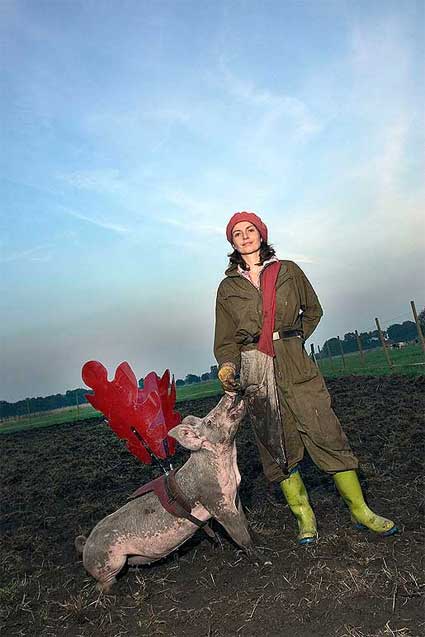
Insa Winkler interviewed farmers of conventional pig farming, studied the mechanisms of industrial meat production, the destruction of landscape with monoculture and fields for liquid manure, etc. She searched a piece of land around Wülknitz, got authorization to keep pigs outside, bought a special breed of pigs and learned how to raise and feed them on acorns. The ham from these pigs will be produced in a local factory, and then sold in local restaurants, throughout Germany and also internationally.
Raising piglets in acorn forests – like some parts of Spain still do today – is not just a romantic ideal, it can also be an important contribution for the biodiversity of landscape.
Insa Winkler created a logo and a public relation vehicle for her project: The Acorn Pig Cinema which transports the film from the Project since 2004.
Parallel to a public discussion, the practicality of The Acorn Pig as an agricultural project is explored, making it both an agricultural and a cultural experiment.
But what if we should keep on breeding, feeding and killing pigs industrially? Is there a way to keep the animal welfare element in the equation? Rotterdam architecture office MVRDV thinks so. The Pig City project, for which they collaborated with the Dutch Ministry of Agriculture, Nature and Fisheries, is a computer simulation of skyscrapers for industrial pig breeding.
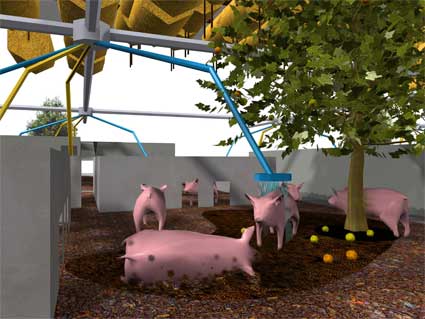
MVRDV: Pig City, 2000-2001. Image courtesy of Edith Russ Haus
Pigs would inhabit stacked ‘apartments’, balconies would allow them to rummage around under trees outside. Pigs for slaughter would be moved in lifts and brought to a central abattoir housed in the plinth. On top, a fish farm would supply some of the food needed. Each tower contains a central slurry-processing plant and a biogas tank, which caters for the tower’s energy needs. To reduce transport costs, towers are located either in the port or close to major cities.
When first presented the project met with heavy discussions: criticism centred on the dangers of centralisation. Should one element be put out of operation, then the consequences for the whole system couldn’t be foreseen. There were also unfavourable comments about the belief that society can reduce nature into models that are then turned into reality. What is more, the pig flats would ‘harm’ the image of the pig-farming sector. Architecture critics in the media were much more receptive and viewed it as a courageous proposal.
Ecological Strategies in Today’s Art runs until January 13 at the ERH in Oldenburg, Germany.
Set of images.
Previous exhibition at the Edith Russ Haus: Soundbytes (part 1 and 2).
Related stories: Edible City, Part 1 and 2. Eyebeam’s Ecoviz Design Challenge panel (part 1), Eyebeam’s Ecoviz Design Challenge panel (part 2).
Now here’s something pretty stupid. AdFreak has the story of a woman that performed a faux orgasm in a video ad for an online jeweler Szul.com. She’s now suing Szul and its production company, Q2 Entertainment, for $5 million…
LONDON – Pearson, publisher of the Financial Times, has acquired Money-Media, a US-based online news and commentary business, for an undisclosed sum.
By now most of you have probably taken a gander at the 2007 Adland Roundup – A look back at the year in advertising. And as usual, we’re bringing you the best, worst, craziest, and otherwise notable ads of the past year. So, enjoy this first bite-sized installment and check back soon for the rest.
Trend Alert: Hand Concepts:
VW – Galanty Show (2007) 1:25 (Germany) and Draught Guinness – Hands (2007) 0:60 (UK)


You might recall the above Szul.com spot, which we wrote about in November. Its “sexy, adult storyline†involved a woman getting orgasmic after receiving a diamond pendant. (Tagline: “Jewelry works every time.â€) Now, it seems the model is suing the online jeweler for mucking up her “wholesome image.†According to court papers dug up by the Associated Press, the unidentified 37-year-old woman says she did not “consent to or authorize the use of her likeness, picture, image or name to simulate a female having an orgasm or otherwise experiencing sexual pleasure.†Also, she only got $200 for the gig. She’s suing for $5 million. The appropriate price tag is probably somewhere in between.
—Posted by Tim Nudd
LONDON – BSkyB is to show a brand new, award-winning feature film on its pay-per-view film channel on the same day as it is released in UK cinemas in a deal with Curzon Artificial Eye.
And I quote: "…Kids of all sizes love the Tiddy Bear." Nice. Boy, what I wouldn’t have paid to be in the room when the name for this product was actually approved. Of course, the real question is how the VO guy actually got through the session. Do you think the client requested auditions? Or do you think he got the gig, walked into the studio and saw the script for the first time? ‘Cause either way, the stuff on the digital cutting room floor has to be pure gold.
You know, this is a good week to look at some of our favorite guilty-pleasure informercials. Send us your thoughts and we’ll see if we can dig ’em up for ya’.
Okie dokie, so big George Parker’s blog AdHurl talked about this already, but I had to chime in. Apparently Pantone, Inc has chosen its color of the year. Yes, the color of the year. My God Alive!
Read below, but know you don’t have to as this is the most ridiculous shit I have ever seen.
“From a color forecasting perspective, we have chosen PANTONE 18-3943 Blue Iris as the color of the year, as it best represents color direction in 2008 for fashion, cosmetics and home products,” explains Leatrice Eiseman, executive director of the Pantone Color Institute®. “As a reflection of the times, Blue Iris brings together the dependable aspect of blue, underscored by a strong, soul-searching purple cast. Emotionally, it is anchoring and meditative with a touch of magic. Look for it artfully combined with deeper plums, red-browns, yellow-greens, grapes and grays.”

Even for those whom Pantone colors give a major nerd-gasm to, I can’t imagine who really followed this heated battle. Did the other colors go out drinking that night to drown their sorrows? Who was the board of experts to choose this groundbreaking color?
Ultimately I ask, is there any point to this? Or is this just a crap PR ploy to add relevance to over inflated Crayola designers? Should it have its own day? I think March 8th is open.
Can’t we just be comfortable saying “we study colors for a living” instead of having some trite award given out to justify our existence?
AAAAGGGGGGGHHHHHHHH!!!!!!!
Take care rockers.
Technorati Tags: pantone inc, crayola, blue iris, beyond madison avenue
For you so-called PPC “marketers” who write “intuitive” ad text and bid just as intuitively (read: wastefully), a thoughtful guy named Ian Fernando put together a Google Docs tool to (quantitatively!!!!) determine who clicks on what keywords, and how…
Cracked’s compilation of the 10 Most Laughably Misleading Ads continues the site’s tradition of being right on the money, as they rightfully point out how stupid “time-saving†products make the average American look. Lazy, too. Magnetic pens (promoted in the video above) were designed for people too sedentary to reach under the chair and retrieve one. (The ad also suffers from repeated, not-so-subtle boob shots.) And don’t even get me started on the Handy Peel, whose interactions with carrots remind me a little too much of the Octodog (click “How Does It Work?â€). I won’t ruin the rest of this list for you, but I’ll leave saying that the Tiddy Bear both is and isn’t what it sounds like.
—Posted by David Kiefaber
LONDON – IPC has agreed to sell its only parenting title, Practical Parenting, to Magicalia, publisher of a number of other parenting titles, for a confidential sum.
To drive people into the arms of Philly, the Greater Philadelphia Tourism Marketing Corporation gives us a print campaign called uwishunu (“You wish you knew” in … hipster-language?) which, from what we can tell, is all about people trying…

Lifetime’s push to promote Carson Kressley’s new show, How to Look Good Naked, illustrates the difference between Boston and New York. Here in Boston, “The Hub of the Universe†(and whoever called it that never spent much time on Brighton Ave.), the MBTA bombards subway riders with multimedia ad messages and scary, faceless “Charlie Card†rail passes. In New York’s subways, meanwhile, “a total of 160 women, cloaked in bathrobes and with bras in hand, will flood Manhattan public transport on their way to Times Square on Thursday as part of the ‘March of the Robes’ guerrilla campaign preceding the series premiere at 9 p.m. Friday,†according to The Hollywood Reporter. So there it is. Boston: Fiend without a face. New York: Bathrobes and bras. Now, that’s a hell of a town.
—Posted by David Gianatasio